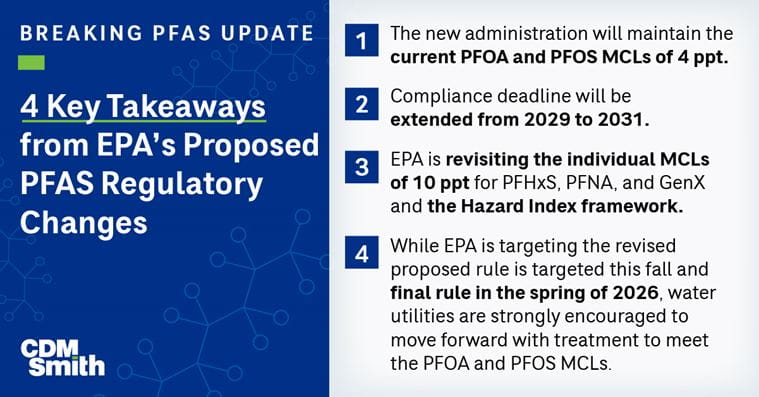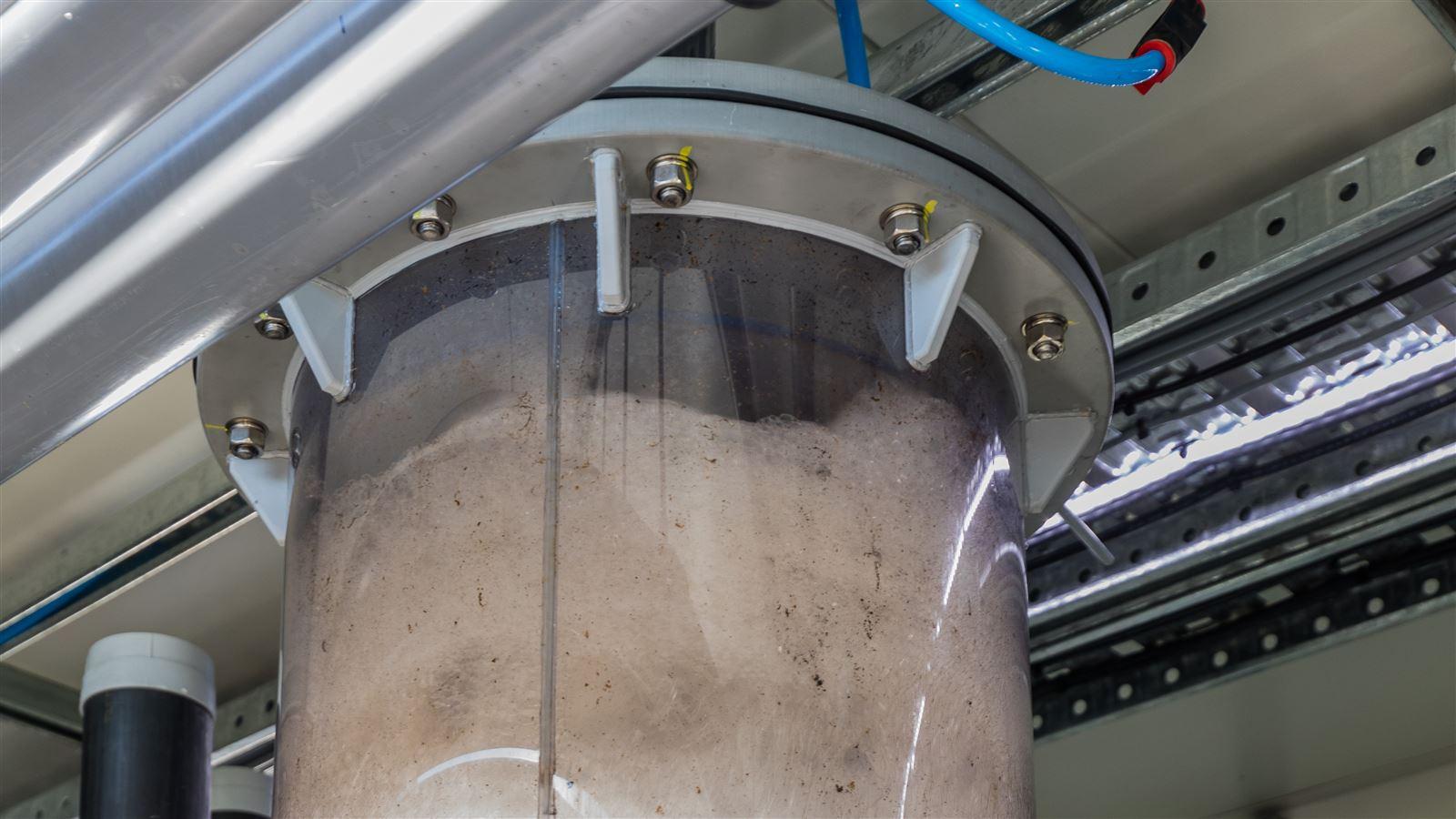Comparing Common PFAS Treatment Options
On June 15, 2022, the U.S. Environmental Protection Agency (EPA) released new health advisories for two PFAS compounds, PFOS and PFOA. Previously set at 70 parts-per-trillion (ppt) for both contaminants, the new advisories decreased significantly to .02 ppt for PFOS and .004 ppt for PFOA.
That plunge in PFAS limits led to another seismic shift. About a year later, the agency proposed the first enforceable drinking water limits for six PFAS tied to adverse health effects, including PFOA and PFOS individually and four additional PFAS (PFBS, PFHxS, PFNA, GenX) in a mixture.

“There's really three steps to solve this problem,” says Al LeBlanc, CDM Smith senior vice president and discipline leader for Water Treatment. “Separate, concentrate, destroy.”
LeBlanc has worked on some of the first PFAS treatment facilities in New England. Based on what he has seen in action, there's a range of maturity among treatment technologies.
"It isn’t just a matter of removing PFAS from drinking water," he says. "Efficiency is critical."
Some things to keep in mind when determining your PFAS treatment approach:
| Sense of scale is important because treatment goals for PFAS are in the low parts-per-trillion. | |
| Inorganic elements in groundwater, like iron and manganese, can hinder performance. | |
| Pay attention to infrastructure factors (chemical usage, hydraulics and electrical capacity.) | |
| Know how to handle residual and discharge options. | |
| Capital cost and operating cost can play important factors when evaluating treatment options. |
There are really three steps to solve this problem: Separate, concentrate, destroy.
Separate
Granular Activated Carbon (GAC)
GAC is the most common treatment method, used for more than 15 years. The activated carbon works by accumulating the PFAS at the interface between liquid and solid phases. It is highly porous and provides a large surface area on which the PFAS can adsorb.
 |
High familiarity |  |
Less effective for short-chain PFAS |
 |
Lower media unit cost |  |
Less effective for highly organic surface waters |
 |
Spent GAC can be reactivated |  |
Larger footprint |
Example: Westfield Successfully Treats PFAS with GAC Unit
Anion Exchange (AIX)
AIX involves the use of synthetic resins made from hydrocarbons. These resins work by attracting and holding contaminated materials from passing through a targeted water source.
 |
Smaller footprint |  |
Higher media unit cost |
 |
Longer bed life |  |
Spent AIX required incineration |
 |
Effective for a wide range of PFAS Higher media unit cost |
Example: AIX & GAC Treat PFAS in Ayer
Membrane Technologies
The two most commonly studied variants are reverse osmosis (RO) and nanofiltration (NF). Low pressure RO has demonstrated a powerful capacity for PFAS removal, including short-chain compounds. While this method has a high capital cost and energy demand, it can beat out other technologies in terms of long-term efficiency.
Low-pressure reverse osmosis (LPRO)
Only recently has LPRO become a valid approach to PFAS removal. Categorized as a membrane technology, LPRO uses high amounts of energy to push water through a taught membrane.
While the upfront costs may be higher, membranes may be able to save on the long-term. In some cases, technologies like low-pressure reverse osmosis (LRPO) has been more efficient removing more compounds over time. In Brunswick County, NC, for example, a team of CDM Smith scientists piloted a LPRO system that removed PFAS compounds down to non-detect limits.
 |
Powerful at removing wide range of PFAS, |  |
High capital costs and energy demand |
| including short-chain |
Example: Brunswick County Conquers PFAS Compounds With LPRO
Nanofiltration (NF)
Data on NF performance are more limited, but positive bench-scale test results have been reported. One of the most important characteristics of these treatment options to note is their generation of a waste stream containing high concentrations of reject contaminants, which requires further management and treatment.
In the future, we hope to destroy PFAS right on site. That would be the ultimate for all of us in the water treatment industry.
Concentrate
Most destructive technologies are impractical for dilute streams. Because they require high amounts of energy, destruction technologies like electro-chemical oxidation, UV-sulfite, plasma and others are best suited for low-volume, high-strength PFAS concentrates. Therefore, onsite destruction will require efficient concentration of the compounds before destruction can occur.
“You can be inefficient and or expensive depending on your starting concentrations and your target effluent concentrations,” says CDM Smith discipline leader for remedial design, Jeff Bamer, who has been testing ways to concentrate and destroy PFAS.
“With these technologies, there's a wide range of experience and maturity and some technologies are still really kind of working out issues that the bench stage, whereas others are more mature and have graduated off the bench, so to speak, and into pilot and field testing."
Bamer anticipates future PFAS destruction solutions with zero waste discharges. Right now, he and other researchers at CDM Smith are testing the concentration capabilities of promising methods, like SAFF®.

SAFF
Together with EPOC Enviro, CDM Smith scientists have been rigorously testing a new treatment train that targets PFAS, one that can separate and concentrate the compounds using a naturally-occurring process called foam fractionation. EPOC Enviro’s Surface Active Foam Fractionation® (SAFF) system is a mobile, ex-situ shipping container capable of reducing the equivalent of an Olympic-size swimming pool down to a single cup of PFAS concentrate.
SAFF® produces a relatively low volume of PFAS concentrate, which is further polished by a low-pressure evaporation process that distills and reduces the effluent into a PFAS hyper-concentrate. For every megaliter (264,172 gallons) of water treated, the SAFF® system produces only a few quarts of hyper-concentrate thereby dramatically reducing overall disposal costs.
CDM Smith researchers are validating foam fractionation as a PFAS treatment option for wastewater reclamation facilities, in-situ groundwater sites, landfills and investigation-derived waste. From data gathered so far, our field-deployed teams have identified the importance of using foaming agents to increase efficiency.
"Some of the best surfactants that we've added are cationic surfactants, which have extremely low ecological toxicity,” says Bamer. From a concentration perspective, CDM Smith's SAFF deployment team was able to able to reduce the volume of water that then needed additional management by about 90,000 times, so 265,000 gallons of water to about 3 gallons.
Foam fractionation effectiveness can vary—depending on the rate of aeration, water quality, PFAS chain lengths, bubble density and sizes, foam collection effectiveness and the targeted concentration factor to reduce the foam volume.
Read more about SAFF: New Tech Achieves 98% Overall PFAS Removal
Destroy
CDM Smith has been investigating PFAS destruction for nearly a decade. Discover the opportunities and risks associated with the latest innovations.

Every site is comprised of different contaminants. We’re in a unique position to make sure a combination of technologies will fit exact site specifications.









